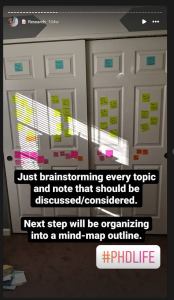Create the Outline
A well-structured outline is the backbone of a formal analytical report. This page reviews the sections you need to outline and the type of content that belongs to each.
What to Do
Make an outline. You could use several tools or methods to keep track of your content
1️⃣Use Sticky Notes on your door, desk, etc. Have one big sticky note for each main section and smaller or different colored stickies for the topics. You can also use digital boards or physical wipe boards for this task.

2️⃣Build the general structure into Microsoft Word (or Google Docs, if you really want). Tag all the main headings as an “H1” or “Heading 1” and any subheadings with H2 or Heading 2.
3️⃣Write the purpose statement and section introduction for each heading. Just focus on the 1-2 sentences that identify why and what this section accomplishes.
4️⃣Review the Tips to Write Better and Faster from Week 1 to develop your writing plan around the outline.
Also… I provided templates for both report options, so maybe download that 🤷♀️
Section Overview
Below are the standard sections of a formal report that build up the context, the methods and validity of the research, the results, and the logic of the final recommendation. Pay attention to the purpose or promise of each section.
I. Executive Summary
- Purpose: Briefly summarize the problem, recommendations, and key findings
Tip: Write this last, after completing your report, to provide a concise overview.
II. Introduction
- Background: Explain the problem or opportunity, provide context, and establish its importance.
- Statement of Need: Clearly define what needs to be addressed and why.
- Scope: Outline the boundaries of your report (what’s included, what’s not).
III. Options
- Option A: Thoroughly describe the option (remember your skills from the Technical Descriptions Project!)
- Option B: Follow the same format.
- Option C (if applicable): Repeat.
Tip: Keep option descriptions consistent in structure for easy comparison.
IV. Evaluation Criteria
- Define Your Criteria: List the factors you will use to judge each option (e.g., cost, feasibility, impact, alignment with mission).
- Explain Importance: Briefly justify why each criterion is relevant.
- Describe how you will research the criteria, including how your primary research (generating new, unpublished data) will be collected and used.
V. Evaluation of Options
- Apply Criteria: Analyze how well each option fulfills each criterion.
- Provide Evidence: Use data, research, and expert opinions to support your assessments.
VI. Recommendation
- State Your Choice: Clearly recommend the best option.
- Justify: Explain the reasoning behind your recommendation, referring to your evaluation.
- Implementation Plan (Optional): Outline key steps for putting your recommendation into action.
VII. Conclusion
- Restate Problem and Solution: Briefly recap the challenge and your recommended course of action.
- Emphasize Impact: Highlight the potential benefits for the think tank and its stakeholders.
VIII. Back Matter
- Provide the reference list in APA or IEEE style
- Include the raw data, questions, and added details of your primary research.
Use the templates provided in each report option. You can download a .docx file (recommended) or a Google Doc. The desktop version of Word has all the tools needed to complete the report, while Docs is missing a few things: captions, IEEE references, and a limited data visual editor.
Tips for Building Your Outline
- Stay Flexible: Your outline is a guide, not a rigid structure. Be prepared to adjust as your research evolves.
- Focus on Logic: Ensure there’s a clear logical flow from problem definition to recommendation. Each section should build upon the previous one.
- Use Subheadings: Break down sections into smaller, more manageable units. This aids readability and comprehension.
Additional Considerations:
- Audience: Consider your audience’s level of technical expertise. Adjust language and explanations accordingly.
- Data Visualizations: Charts, graphs, and tables can effectively summarize complex data.
- Appendices: Include supporting documents or detailed calculations as needed.
AI Disclose: Baseline content generated in Google Gemini with editing, validating, and updating from the author. Prompt: Explain the basic outline of a recommendation report with writing tips. 3/14/2024
